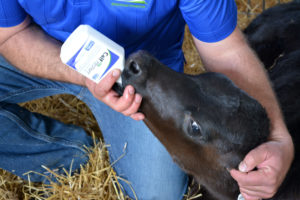Utilizing Two Electrolyte Protocol in Calves
By Dr. Zach Janssen, DVM
In the dairy industry, it is a first principle to provide electrolytes to calves as part of a comprehensive health and welfare program. Most farmers and calf-raisers understand that electrolytes are beneficial to a stressed or dehydrated calf. However, it may be uncommon for that same person to understand how to choose the very best calf electrolyte or how to make a value judgement on which electrolyte to use depending on the circumstances.
The idea of electrolytes
The idea of electrolytes started as an adjunct therapy in children dehydrated from cholera. It was brought to athletes by the researchers at University of Florida and branded as Gatorade®. Essentially, salt, sugar, potassium, and chloride were all that was thought to be necessary to support rehydration. Now we know more; yet some of the products being used in calf rehydration therapy still follow these same outdated strategies.

Stress vs. scouring
Stressful events for calves include but may not be limited to temperature extremes, transportation, vaccination, dehorning, weaning, diet change and socialization/re-socialization. The first several weeks of life can be very stressful yet, will ultimately set the stage for how that animal will perform for the rest of its life. Such stresses are why many farmers and calf-raisers have decided to incorporate an electrolyte into the diet of their calves as a routine management practice. Most often electrolytes are offered in-between milk feedings. These producers recognize the importance water intake has on feed intake and how routine electrolytes can drive water intake and absorption.
Scouring calves present a dirtier situation. Scouring calves lose more fluid and critical electrolytes of sodium (Na), potassium (K), and chloride (Cl), with sodium being the most critical. The best electrolytes contain amino acids, such as glycine and other ingredients that will facilitate the absorption of sodium. High quality electrolytes also have the appropriate osmolarity to stimulate proper absorption in the gastro-intestinal tract. This can be a delicate balancing act as each nutrient added to an electrolyte can increase the osmolarity. Finally, a buffering agent must be added to overcome the acidemia that calves face. Not all buffers are created equal and university experts have determined sodium acetate to be the best and sodium bicarbonate to be the poorest.
Today’s most progressive farms utilize a two-level electrolyte strategy. A simple electrolyte designed to drive water intake and absorption is utilized for stressful situations as described above and fed on a routine basis. Calves that are experiencing a digestive upset or scouring episode receive an electrolyte that is specifically formulated to meet their needs, including a buffering agent. Tailor your electrolyte supplementation to meet a calf’s requirements for a given situation and develop written protocols to provide that product in a proper and timely fashion.
First published in DCHA Heifer Notes. Read the article here.
